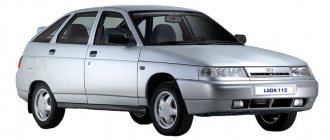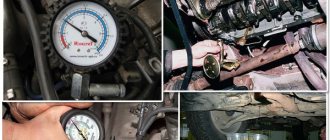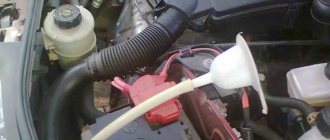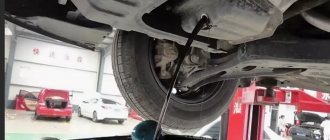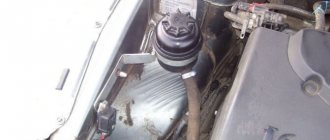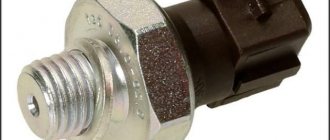Motor oil in any car ensures normal engine operation under various loads and operation at high speeds for a long time. A lot depends on what kind of lubricant is poured. It reduces friction between sliding surfaces and provides micro-sealing between piston rings and cylinders. Therefore, changing the oil in the Peugeot 308 engine is a very important component when caring for the car.
This allows the engine not only to reveal its operating potential, but also to prevent premature failure of its individual components. In addition to its lubricating function, oil also has a cooling effect for parts that tend to get very hot.
Peugeot 308: Business card
When changing the oil in the engine, the massive steel sheet will have to be removed, otherwise you won’t be able to get to the drain plug - it’s right between the slots in the protection. You can cut off one of the lintels, thereby expanding the window, but first weigh whether it’s worth it. No matter how hard you try, when replacing the filter, part of the waste will still end up on the steel sheet.
If you do remove the protection, do not rush to put it back in place; at the same time, check the oil in the box. Alas, neither the manual transmission nor the automatic transmission has a control plug or dipstick. If, say, oil is leaking through the seals, how much should I add? Therefore, we do this: unscrew the drain plug in the manual transmission and release all the waste to the drop. We wrap the cork. Through another hole (it’s on top of the crankcase) we fill in exactly 2 liters of fresh oil. Now the level will be normal. According to the regulations, the oil is “lifetime”, but dealers recommend changing it every 100 thousand km. The same with automatic transmission. If the unit regularly overheats during sudden starts or slipping on a bad road, it is better to change the oil.
Peugeot dealers drain the automatic transmission waste by unscrewing only the lower plug (with the engine not running). Then pour 2 liters through the top hole (we’ll tell you how to get to it later) and start the engine. Having moved the selector through all positions with a two-second delay in each, leave the lever in position P and, without turning off the engine, unscrew the drain plug again. Excess oil will flow out and the level will return to normal.
Getting ready for replacement
The manufacturer's recommendations state that it is necessary to replace the lubricant in the Peugeot 308 after a year of operation of the car or at the turn of 20,000 km. However, these periods are halved taking into account operating conditions: poor condition of the road surface, mountainous terrain, sandy and dusty areas, as well as driving with frequent braking, for example, in traffic jams.
Peugeot 308 engines have a certain peculiarity - when they reach a mileage of 50,000 km, they consume oil. The amount of petroleum product consumed during operation is determined at 500 ml per 1000 km of distance traveled.
ACCESS IS LIMITED
While the protection is removed, replace the coolant. There is no faucet on the radiator, so we remove the lower pipe and, trying not to get wet, catch the flow into a wide container. To drain residues from the pump, there is a special plug on one of the pipes. It’s just not easy to get close to it - it’s very cramped. Because of this, it is rarely removed, and, believe me, nothing bad happens.
After filling in with fresh fluid, remove air from the system. It has two fittings: in the upper heater pipe (at the front panel) and on top of the thermostat (see photo).
Replacement process
The entire replacement procedure is quite simple even for a beginner. Of course, if you are unsure of your abilities or are afraid of getting dirty, you can seek the services of specialized services and spend money. But if you want to do the work yourself, we will tell you in detail how to do it quickly and easily.
To begin the procedure, you need to prepare the tools and accessories necessary for the work.
Tools
To replace you will need:
- recommended or alternative engine oil with a volume of 7 liters;
- original oil filter (catalog number 1109AH);
- a set of keys and screwdrivers (namely: hex key “8”, wrench with a head “27”);
- sealing ring of the drain plug (catalog number 0313.38);
- a container for draining used oil (a bucket or canister with a cut hole with a volume of at least 5 liters);
- latex gloves;
- funnel for pouring liquid into the engine crankcase;
- clean rag or rags.
Original oil element with O-ring
OPTICAL ILLUSION
If the turn signal in the headlight fails, many owners wonder which bulb to change - internal or external? Be aware: the lamp is located outside, and in the internal prop section it is only reflected. It is easier to change headlight bulbs in the right headlight - there is better access there. However, it’s tolerable on the left side as well. The only serious inconvenience is that the cap for the low beam and headlight sections is not centered. Because of this, you will have to tinker with the spring clamp of the lamp.
Unlike other models (206, 407 and some others), the “308” does not have windows in the fender liners for access to the foglights. In fact, this is not a problem, since the bumper with the fender liner can be easily bent and the lamp can be removed through the resulting gap. But the lights need to be removed entirely. No tool is needed for this operation, but for some reason many owners are afraid of this procedure and drive around with burnt out light bulbs.
What kind of oil should I use?
Among the features of any engine, certain oils must be poured into it. For the Peugeot 308, the manufacturer indicated in the service book which lubricant he recommends - these are products.
Depending on the climate and severity of operating conditions, you can pour motor oil from the list listed:
- Total Quartz Energy SAE 0W-30 viscosity;
- Total Quartz 9000 SAE 5W-40;
- Total Quartz Ineo SAE 5W-30.
Of course, this list does not limit your choice; you can pour other motor oil from different manufacturers with the appropriate characteristics. According to the information specified in the service book, it is necessary to adhere to a quality level not lower than API - SJ, SL, ACEA - A3/B4, ILSAC - GF-3 and viscosity class according to SAE - 0W-30 and 5W-30.
Also, by contacting your brand dealer, you can choose an alternative product that may be suitable for your Peugeot 308.
Oil level in automatic transmission.
For an experienced driver, changing the oil in the box correctly is easy. But for those who have just started driving a car, or have always used the services of a car service, this is a difficult question for them. If you belong to the second group, do not be discouraged; after studying this article and watching videos on the Internet, you will be able to do everything correctly without any problems.
This topic is relevant because, even when studying at a professional driving school, no time is devoted to this issue, although the entire structure of the car is studied (of course, schools are different, but in 98 percent, in the opinion of teachers, students should already know most of the simple questions). Everyone should know how to do this correctly, even if you are not going to change the oil yourself.
How much liquid do you need?
The total volume of fluid in the Peugeot 308 is 7 liters. As a rule, a complete fluid change in an AL4 automatic transmission is not carried out at one time. That is why experts recommend partially draining the liquid. Approximately every 30-40 thousand kilometers.
To carry out a complete drain, 9 liters are needed, for a partial drain, 3 to 4 liters are enough. It is worth considering that special equipment is required to carry out a complete drain, so it is best to carry out this procedure at a service station. You can do a partial replacement yourself.
What lubricant and how often to refill
It is very important to remember that the manual transmission and the AL4 automatic transmission use fundamentally different products. Special transmission fluids have been developed for automatic transmissions - ATF. Such lubricants are subject to increased requirements for:
- degree of viscosity;
- antifriction properties;
- antioxidant qualities;
- anti-wear indicators;
- anti-foam features.
ATF for automatic transmission AL4 stabilizes the operation of the torque converter. A special fluid in the automatic transmission reduces the thermal load on the friction elements. The oil washes away products formed due to the degree of wear of parts and ensures the correct functionality of the control system.
Mineral, semi-synthetic, and synthetic oils can be used in automatic transmissions. They differ in chemical composition, sets of additives and basic properties. Also, these lubricants have varying degrees of aggressive (destructive) effects on rubber sealing parts.
According to the advice of users and specialists, the optimal lubricant for the Peugeot 308 automatic transmission is ATF LT 71141. Smooth operation of the transmission is ensured by a balanced additive system. The recommended liquid has proven its effectiveness at low temperatures. ATF LT 71141 can be changed at longer intervals.
The Peugeot 308 automatic transmission fluid is replaced, according to the recommendations of users and specialists, after 30,000–40,000 km. The oil should also be changed at certain intervals, taking into account its aging.
Do we check the oil level in the automatic transmission correctly?
For all brands of cars, it is usually not difficult. Correct checking of the oil level in the automatic transmission should occur with the engine warm and running. When cold, the readings will be incorrect. To warm up the engine, start it and drive it for about fifteen minutes. If you drove your car for a long time at a speed above one hundred km before checking, then you should wait half an hour. That is, the oil temperature should be between 70 and 90 degrees
If you stop on a level area, if the car is standing even at a slight slope, the test result will be useless and even harmful. Since you can fill the oil above the ADD mark, while overfilling is even higher than normal, or, conversely, not adding oil at FULL. After this, on the automatic transmission, set the lever to the “P” position, on some models “N”. If you can’t find the dipstick to check, it’s usually located under the hood so you don’t have to spend a long time searching for it. Watch the video. If you have a dipstick, then there are from two to four marks on it. Two marks for checking on cold engines and two on hot. In most cases, there are only two of them.
Attention. On Peugeot cars, there is no dipstick in the automatic transmission, except for models 4007 and 4008, checking the oil for Peugeot
The lower mark is the minimum level, the upper mark is the maximum. We take out the dipstick and wipe it with a cloth. We lower the dipstick into the box again. Raise the dipstick and look at the marks. The correct oil level in the automatic transmission should be between the lower and upper marks. Pay attention to the color of the oil.
You may have an electronic probe. Oil checking is computerized, you don’t have to look for a dipstick or check plug.
Warm up the car, this will take about 5 minutes. Then you need to go to the CAR menu, turn off the car and turn on the ignition again; you cannot start the engine. Also, do not press the brake pedal. We wait about a minute and check the oil.
On newer models there is no dipstick and then you need to look for a control plug, for example a BMW car from ZF. It is located on the crankcase, at the bottom of the box. For your safety, the test is carried out on a cold box. To properly check the level, you will need to raise your car, on an overpass or put it in a hole, make sure that the car is level.
You need to start the engine, it must be cold. Wait about a minute and shift the box first from R for 3 seconds and in the next gears wait the same amount of time. Then into D, next gear N, don't forget about 3 seconds in each gear. And lastly R and in reverse order. That is, we change all gears at intervals of three seconds (all boxes are different and the number of gears is different). This is done so that the oil spreads evenly throughout the box .
Before checking, we remove the engine protection in advance, since if you do not remove it, you will not have access to the box. Usually you will need wrenches 13 and 17. Before removing the bolts, it is advisable to treat them with a liquid, such as a liquid wrench, so as not to tear off the bolts. They are mostly rusty. Before screwing them back in, clean the bolts and lubricate them with fluid. Protects bolts from corrosion.
On the crankcase there will be a main plug for complete drainage of oil and a small one, which is exactly what you need. It will be a hexagon or tetrahedron. The advantage of this is that you will not be able to overfill. Using a diagnostic computer, we monitor the oil temperature. At 30-50 degrees at the optimal level, it will pour out. If the oil starts pouring out earlier, the level is too high. If it's over 50 degrees, it starts pouring out and you have a low level in the box.
There are exceptions everywhere, for example Honda and Acura cars; on these cars the level is measured after the engine has been heated to 90 degrees. But it is correct to check with the engine off. A particularly interesting case is the Mercedes 722.6. For this brand of car, and subsequent models produced, engineers did not provide devices for measuring the oil level. The container where we usually fill oil has a connection to the engine sump through a bypass valve, the purpose of which is to constantly maintain the optimal level.
An important question for beginners is how much oil the box can hold, and how much you need to buy to replenish the required level. DAIHATSU TERIOS holds a little more than four liters in a box, Ford Expedition up to 15.5 liters. But keep in mind that 100 percent of the oil does not escape; some of it always remains in the gearbox (this is true for all cars and this is normal). On average, it takes about two to four liters to top up (this is very approximate, since it is impossible to derive a general indicator for all cars)


